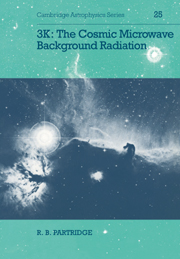Book contents
- Frontmatter
- Contents
- Preface
- 1 Cosmology
- 2 The early history of CBR studies
- 3 Radio astronomy
- 4 The spectrum of the CBR
- 5 What we learn from observations of the CBR spectrum
- 6 Searches for anisotropy in the CBR on large angular scales
- 7 Searches for anisotropy in the CBR on small angular scales
- 8 What do we learn from the angular distribution of the CBR?
- Appendix A A measurement of excess antenna temperature at 4080 Mc/s
- Appendix B Cosmic blackbody radiation
- Appendix C Recent results
- Index
2 - The early history of CBR studies
Published online by Cambridge University Press: 17 September 2009
- Frontmatter
- Contents
- Preface
- 1 Cosmology
- 2 The early history of CBR studies
- 3 Radio astronomy
- 4 The spectrum of the CBR
- 5 What we learn from observations of the CBR spectrum
- 6 Searches for anisotropy in the CBR on large angular scales
- 7 Searches for anisotropy in the CBR on small angular scales
- 8 What do we learn from the angular distribution of the CBR?
- Appendix A A measurement of excess antenna temperature at 4080 Mc/s
- Appendix B Cosmic blackbody radiation
- Appendix C Recent results
- Index
Summary
It is fair to claim that the cosmic background, announced in 1965, was discovered by telephone. As we will see, this radiation had been both observed and predicted before a fateful 1964 telephone call from Arno Penzias and Robert Wilson of the Bell Telephone Laboratories to Robert Dicke at Princeton, a few miles away. Nevertheless, that telephone conversation led to the recognition that the source of the puzzling ‘excess noise’ observed by Penzias and Wilson was in fact a relic of the Hot Big Bang.
In this chapter, I will start with a brief review of the state of cosmology in the early 1960s, look at earlier predictions of the radiation, particularly the prescient work of Gamow and his colleagues, and then attempt to unravel the complicated knot of circumstances that led to the telephone call of late 1964. Later in the chapter, I will describe the important early experiments which established the cosmological nature of the radiation first detected by Penzias and Wilson, and then sketch the subsequent history of the field.
Cosmology in the early 1960s
Thirty years ago, cosmology played a far less central role in physics and astronomy than it does today. For instance, cosmology is nowhere mentioned in the text I was assigned in my first college astronomy course more than thirty years ago; the word ‘Universe’ appears only twice, where it is used, inappropriately, to refer to the Milky Way.
- Type
- Chapter
- Information
- 3K: The Cosmic Microwave Background Radiation , pp. 42 - 58Publisher: Cambridge University PressPrint publication year: 1995



